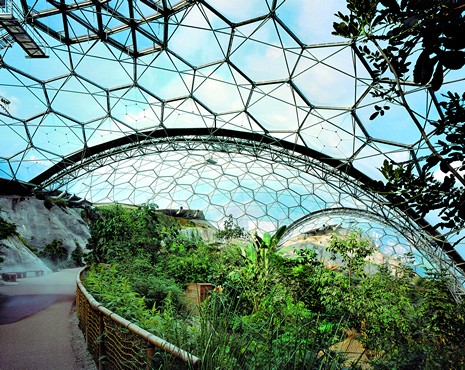Description
Nicholas Grimshaw’s Eden Project – which the English press hailed as the eighth wonder of the world before it was even completed – showcases the tropical rainforest and the Mediterranean flora and fauna in an artificial biosphere in a northern European environment. The project strives to establish its own ecological system and to raise the visitors’ awareness for the world of plants. Under eight large transparent domes, tropical ornamental plants as well as commonly known useful plants such as olive trees, coffee, tea, or cotton are cultivated and exhibited on 23,000 m², with 416,000 m³ and up to 50 m in height.
The layout is split into two climatic zones by two large building envelopes: a tropical wetland zone with a base temperature of 32°C provides a habitat for some 12,000 subtropical plants and a warm-temperate zone houses Mediterranean plants. The entrance and visitors center are unobtrusively situated under a green roof between these two zones. Both groups of domes are formed by four semi-spheres each and, accordingly, are a prominent feature within the landscape.
The architect and the engineers jointly derived the structure for the column-free spaces from the honeycomb structures which are common in nature. The structure also goes back to Buckminster Fuller’s geodesic domes. The loads of the filigree structure are not transmitted via point supports but are distributed linearly along the edge of the floor space. The geometrical domes are composed of hexagons forming a lightweight and stiff structure. Some 4,000 nodes and 11,000 rods form a double-layered semi-spherical steel space truss. The outer layer is composed of a hexagonal structure; the inner layer is a net composed of triangles and hexagons. The breaking-up of the structure into small members reduces its weight. At the coalescing lines of the spheres, complex hot-dip galvanised three-chord steel trusses connect the frameworks of the individual spheres and transmit the loads to the foundations. This structural system allows for precise prefabrication and inexpensive delivery of all elements.
Since the poor load-bearing capacity of the ground called for a lightweight structure as well as a lightweight envelope, the architect chose transparent foil cushions for the building envelope. They consist of high-strength triple-layered ethylene-tetrafluoroetyhlene (ETFE) foil to cover an area of 30,000 m². The hexagonal foil cushions – some of which are up to 2 m thick – allow more UV-light to enter the building than glass; because of the air-cushions inside they provide excellent thermal insulation. Hence, as an additional effect, heating costs could be reduced.
The subtropical climate requires a special ventilation system. For this purpose, at the highest point of each dome 30 remote-controlled ventilation flaps have been installed. Due to the surface tension of the cushions they possess self-cleaning properties: dust and debris are washed away by rainwater, which can be collected, filtered, and recycled for use in the greenhouses.
Drawings
Site plan
Top view
Floor plan diagram
Schematic section
Section through the visitor’s center
Photos

Exterior view of the world’s largest greenhouse with eight geodesic domes

Complex three-chord trusses between the coalescing geodesic domes
Originally published in: Jürgen Adam, Katharina Hausmann, Frank Jüttner, Industrial Buildings: A Design Manual, Birkhäuser, 2004.